Effects of Meteorology Nudging in Regional Hydroclimatic Simulations of the Eastern Mediterranean
Abstract
1. Introduction
2. Data and Methods
2.1. Model Setup
2.2. Observational and Reanalysis Data
2.3. Annual and Monthly Comparison
2.4. Precipitation Characteristics and Indices
- Consecutive dry days (CDD): The greatest number of consecutive days with precipitation lower than 1 mm, within a year.
- Consecutive wet days (CWD): The greatest number of consecutive days with precipitation higher or equal to 1 mm, within a year.
- Annual count of rainy days (RR1): The annual count of days with observed rainfall greater than 1 mm.
- Annual count of days with precipitation larger than 20 mm (R20).
- Highest five-day precipitation amount for each year (RX5D).
- Simple precipitation intensity index (SDII): Annual sum of precipitation during wet days (precipitation > 1 mm) divided by the annual count of wet days.
2.5. Statistical Metrics
- Spearman’s correlation coefficient (COR) was applied on the ranked monthly time series [36]:where n is the number of the sample, cov is covariance, and σ is the standard deviation. Significance of the correlations was assessed by the application of a t-test at the 95% significance level.
- The mean absolute error (MAE) was used to describe the average model performance error [37]:
- The modified index of agreement (MIA) was used as a standardized measure of the degree of the model prediction error [38,39]. This index varies between 0 and 1, with higher values indicating better agreement between the model and observations. It was introduced by Willmott [38] and refined by Legates and McCabe [39]:
- The threat score (TS) was used to measure the skill of predicting the area of precipitation for a certain threshold [8]. For this study, it was applied for the thresholds that defined each precipitation class in Section 2.4:where P is the number of grid points in which the threshold amount of precipitation was simulated, O is the number of grid points in which the threshold amount was observed, and H is the number of grid points for which threshold precipitation was both simulated and observed. Values closer to 1 indicated a better agreement with the observations.
3. Results
3.1. Annual Precipitation
3.2. Precipitation Characteristics and Indices
3.3. Statistical Metrics
3.4. Monthly Precipitation at Stations
3.5. The Case of Cyprus
3.6. Computational Cost
4. Discussion and Conclusions
Supplementary Materials
Author Contributions
Funding
Acknowledgments
Conflicts of Interest
References
- Lucas-Picher, P.; Cattiaux, J.; Bougie, A.; Laprise, R. How does large-scale nudging in a regional climate model contribute to improving the simulation of weather regimes and seasonal extremes over North America? Clim. Dyn. 2016, 46, 929–948. [Google Scholar] [CrossRef]
- Liu, P.; Tsimpidi, A.P.; Hu, Y.; Stone, B.; Russell, A.G.; Nenes, A. Differences between downscaling with spectral and grid nudging using WRF. Atmos. Chem. Phys. 2012, 12, 3601–3610. [Google Scholar] [CrossRef]
- Alexandru, A.; de Elia, R.; Laprise, R.; Separovic, L.; Biner, S. Sensitivity study of regional climate model simulations to Large-Scale nudging parameters. Mon. Weather Rev. 2009, 137, 1666–1686. [Google Scholar] [CrossRef]
- Spero, T.L.; Otte, M.J.; Bowden, J.H.; Nolte, C.G. Improving the representation of clouds, radiation, and precipitation using spectral nudging in the weather research and forecasting model. J. Geophys. Res. Atmos. 2014, 119, 11682–11694. [Google Scholar] [CrossRef]
- Stauffer, D.R.; Seaman, N.L. Use of Four-Dimensional data assimilation in a Limited-Area mesoscale model. Part I: Experiments with Synoptic-Scale data. Mon. Weather Rev. 1990, 118, 1250–1277. [Google Scholar] [CrossRef]
- Von Storch, H.; Langenberg, H.; Feser, F. A spectral nudging technique for dynamical downscaling purposes. Mon. Weather Rev. 2000, 128, 3664–3673. [Google Scholar] [CrossRef]
- Omrani, H.; Drobinski, P.; Dubos, T. Optimal nudging strategies in regional climate modelling: Investigation in a Big-Brother experiment over the European and Mediterranean regions. Clim. Dyn. 2013, 41, 2451–2470. [Google Scholar] [CrossRef]
- Lo, J.C.-F.; Yang, Z.-L.; Pielke, R.A., Sr. Assessment of three dynamical climate downscaling methods using the Weather Research and Forecasting (WRF) model. J. Geophys. Res. Atmos. 2008, 113, D09112. [Google Scholar] [CrossRef]
- García-Díez, M.; Fernández, J.; Fita, L.; Yagüe, C. Seasonal dependence of WRF model biases and sensitivity to PBL schemes over Europe. Q. J. R. Meteorol. Soc. 2013, 139, 501–514. [Google Scholar] [CrossRef]
- Arritt, R.W.; Rummukainen, M. Challenges in Regional-Scale climate modeling. Bull. Am. Meteorol. Soc. 2011, 92, 365–368. [Google Scholar] [CrossRef]
- Bowden, J.H.; Otte, T.L.; Nolte, C.G.; Otte, M.J. Examining interior grid nudging techniques using Two-Way nesting in the WRF model for regional climate modeling. J. Clim. 2012, 25, 2805–2823. [Google Scholar] [CrossRef]
- Miguez-Macho, G.; Stenchikov, G.L.; Robock, A. Spectral nudging to eliminate the effects of domain position and geometry in regional climate model simulations. J. Geophys. Res. Atmos. 2004, 109. [Google Scholar] [CrossRef]
- Castro, C.L.; Pielke, R.A.; Leoncini, G. Dynamical downscaling: Assessment of value retained and added using the regional atmospheric modeling system (RAMS). J. Geophys. Res. 2005, 110. [Google Scholar] [CrossRef]
- Deng, A.; Stauffer, D.R. On improving 4-km mesoscale model simulations. J. Appl. Meteorol. Climatol. 2006, 45, 361–381. [Google Scholar] [CrossRef]
- Salathé, E.P.; Steed, R.; Mass, C.F.; Zahn, P.H. A High-Resolution climate model for the U.S. pacific northwest: Mesoscale feedbacks and local responses to climate change. J. Clim. 2008, 21, 5708–5726. [Google Scholar] [CrossRef]
- Otte, T.L.; Nolte, C.G.; Otte, M.J.; Bowden, J.H. Does nudging squelch the extremes in regional climate modeling? J. Clim. 2012, 25, 7046–7066. [Google Scholar] [CrossRef]
- Bullock, O.R.; Alapaty, K.; Herwehe, J.A.; Mallard, M.S.; Otte, T.L.; Gilliam, R.C.; Nolte, C.G. An Observation-Based investigation of nudging in WRF for downscaling surface climate information to 12-km grid spacing. J. Appl. Meteorol. Climatol. 2013, 53, 20–33. [Google Scholar] [CrossRef]
- Lelieveld, J.; Proestos, Y.; Hadjinicolaou, P.; Tanarhte, M.; Tyrlis, E.; Zittis, G. Strongly increasing heat extremes in the Middle East and North Africa (MENA) in the 21st century. Clim. Chang. 2016, 137, 245–260. [Google Scholar] [CrossRef]
- Zittis, G. Observed rainfall trends and precipitation uncertainty in the vicinity of the Mediterranean, Middle East and North Africa. Theor. Appl. Climatol. 2018, 134, 1207–1230. [Google Scholar] [CrossRef]
- Skamarock, W.C.; Klemp, J.B.; Dudhia, J.; Gill, D.O.; Barker, D.M.; Duda, M.G.; Huang, X.-Y.; Wang, W.; Powers, J.G. A Description of the Advanced Research WRF Version 3; NCAR Technical Note, NCAR/TN-475+STR; National Center for Atmospheric Research: Boulder, CO, USA, 2008. [Google Scholar]
- Simmons, A.; Uppala, S.; Dee, D.; Kobayashi, S. ERA-interim: New ECMWF reanalysis products from 1989 onwards. ECMWF Newsl. 2007, 110, 26–35. [Google Scholar] [CrossRef]
- Zittis, G.; Hadjinicolaou, P.; Lelieveld, J. Comparison of WRF model physics parameterizations over the MENA-CORDEX domain. Am. J. Clim. Chang. 2014, 3, 490–511. [Google Scholar] [CrossRef]
- Zittis, G.; Bruggeman, A.; Camera, C.; Hadjinicolaou, P.; Lelieveld, J. The added value of convection permitting simulations of extreme precipitation events over the eastern Mediterranean. Atmos. Res. 2017, 191, 20–33. [Google Scholar] [CrossRef]
- Zittis, G.; Hadjinicolaou, P. The effect of radiation parameterization schemes on surface temperature in regional climate simulations over the MENA-CORDEX domain. Int. J. Climatol. 2017, 37, 3847–3862. [Google Scholar] [CrossRef]
- Janjić, Z.I. The Step-Mountain eta coordinate model: Further developments of the convection, viscous sublayer, and turbulence closure schemes. Mon. Weather Rev. 1994, 122, 927–945. [Google Scholar] [CrossRef]
- National Oceanic and Atmospheric Administration (NOAA). Changes to the NCEP Meso Eta Analysis and Forecast System: Increase in Resolution, New Cloud Microphysics, Modified Precipitation Assimilation, Modified 3DVAR Analysis. Available online: http://etamodel.cptec.inpe.br/documentation/ (accessed on 29 November 2018).
- Iacono, M.J.; Delamere, J.S.; Mlawer, E.J.; Shephard, M.W.; Clough, S.A.; Collins, W.D. Radiative forcing by long-lived greenhouse gases: Calculations with the AER radiative transfer models. J. Geophys. Res. Atmos. 2008, 113. [Google Scholar] [CrossRef]
- Tewari, M.; Chen, F.; Wang, W.; Dudhia, J.; LeMone, M.A.; Mitchell, K.; Ek, M.; Gayno, G.; Wegiel, J.; Cuenca, R.H. Implementation and verification of the unified NOAH land surface model in the WRF model. In Proceedings of the 20th Conference on Weather Analysis and Forecasting/16th Conference on Numerical Weather Prediction, Seattle, WA, USA, 12–16 January 2004. [Google Scholar]
- Maraun, D.; Widmann, M.; Gutiérrez, J.M.; Kotlarski, S.; Chandler, R.E.; Hertig, E.; Wibig, J.; Huth, R.; Wilcke, R.A.I. VALUE: A framework to validate downscaling approaches for climate change studies. Earths Future 2015, 3, 1–14. [Google Scholar] [CrossRef]
- Vonder Haar, T.H.; Bytheway, J.L.; Forsythe, J.M. Weather and climate analyses using improved global water vapor observations. Geophys. Res. Lett. 2012, 39. [Google Scholar] [CrossRef]
- Harris, I.; Jones, P.D.; Osborn, T.J.; Lister, D.H. Updated high-resolution grids of monthly climatic observations—The CRU TS3.10 dataset. Int. J. Climatol. 2014, 34, 623–642. [Google Scholar] [CrossRef]
- Funk, C.; Peterson, P.; Landsfeld, M.; Pedreros, D.; Verdin, J.; Shukla, S.; Husak, G.; Rowland, J.; Harrison, L.; Hoell, A.; et al. The climate hazards infrared precipitation with stations—A new environmental record for monitoring extremes. Sci. Data 2015, 2, 150066. [Google Scholar] [CrossRef] [PubMed]
- Haylock, M.R.; Hofstra, N.; Klein Tank, A.M.G.; Klok, E.J.; Jones, P.D.; New, M. A European daily high-resolution gridded dataset of surface temperature and precipitation. J. Geophys. Res. Atmos. 2008, 113, D20119. [Google Scholar] [CrossRef]
- Huffman, G.J.; Adler, R.F.; Bolvin, D.T.; Gu, G.; Nelkin, E.J.; Bowman, K.P.; Hong, Y.; Stocker, E.F.; Wolff, D.B. The TRMM Multi-Satellite Precipitation Analysis: Quasi-Global, Multi-Year, Combined-Sensor Precipitation Estimates at Fine Scale. J. Hydrometeorol. 2007, 8, 38–55. [Google Scholar] [CrossRef]
- Camera, C.; Bruggeman, A.; Hadjinicolaou, P.; Pashiardis, S.; Lange, M.A. Evaluation of interpolation techniques for the creation of gridded daily precipitation (1 × 1 km2); Cyprus, 1980–2010. J. Geophys. Res. Atmos. 2014, 119, 693–712. [Google Scholar] [CrossRef]
- Spearman, C. The proof and measurement of correlation between two things. Am. J. Psychol. 1904, 15, 72–101. [Google Scholar] [CrossRef]
- Willmott, C.J.; Matsuura, K. Advantages of the mean absolute error (MAE) over the root mean square error (RMSE) in assessing average model performance. Clim. Res. 2005, 30, 79–82. [Google Scholar] [CrossRef]
- Willmott, C.J. On the validation of models. Phys. Geogr. 1981, 2, 184–194. [Google Scholar] [CrossRef]
- Legates, D.R.; McCabe, G.J. Evaluating the use of “goodness-of-fit” measures in hydrologic and hydroclimatic model validation. Water Resour. Res. 1999, 35, 233–241. [Google Scholar] [CrossRef]
- Meredith, E.P.; Maraun, D.; Semenov, V.A.; Park, W. Evidence for added value of convection-permitting models for studying changes in extreme precipitation. J. Geophys. Res. Atmos. 2015, 120, 12500–12513. [Google Scholar] [CrossRef]
- Prein, A.F.; Langhans, W.; Fosser, G.; Ferrone, A.; Ban, N.; Goergen, K.; Keller, M.; Tölle, M.; Gutjahr, O.; Feser, F.; et al. A review on regional convection-permitting climate modeling: Demonstrations, prospects, and challenges. Rev. Geophys. 2015, 53, 323–361. [Google Scholar] [CrossRef] [PubMed]
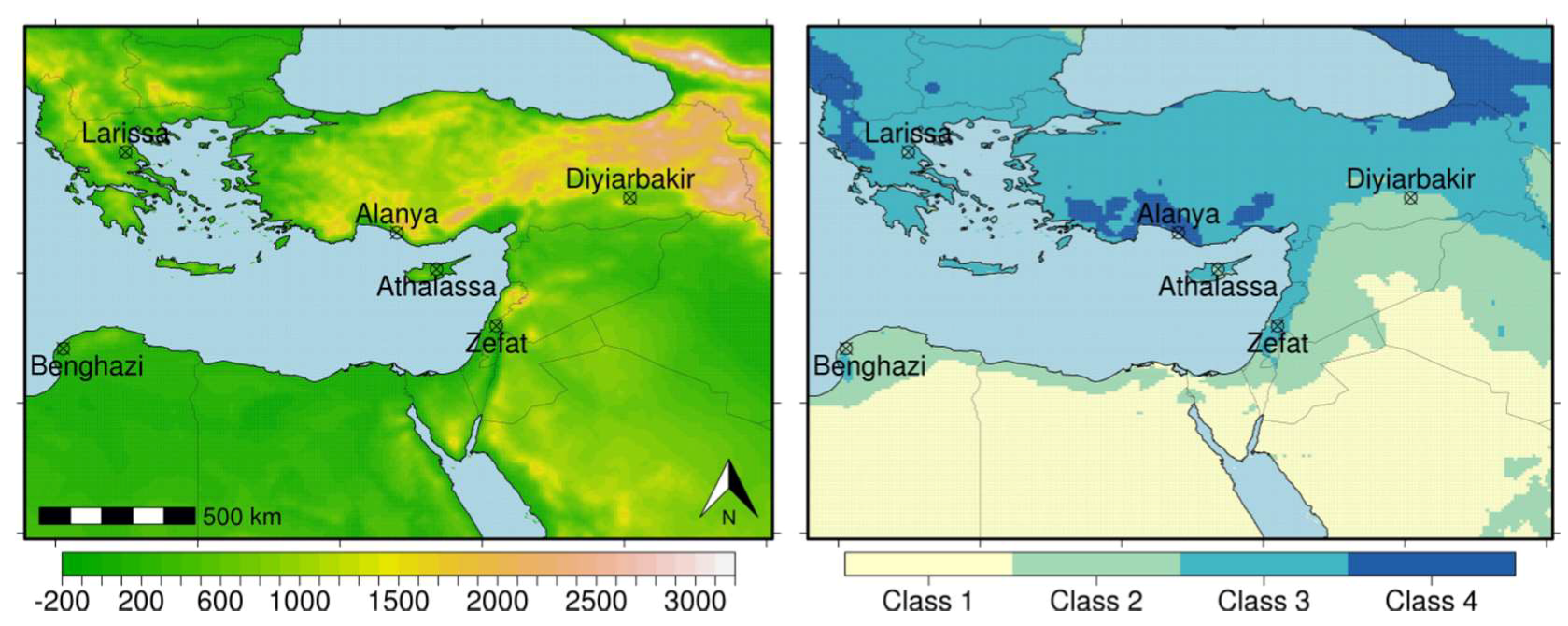
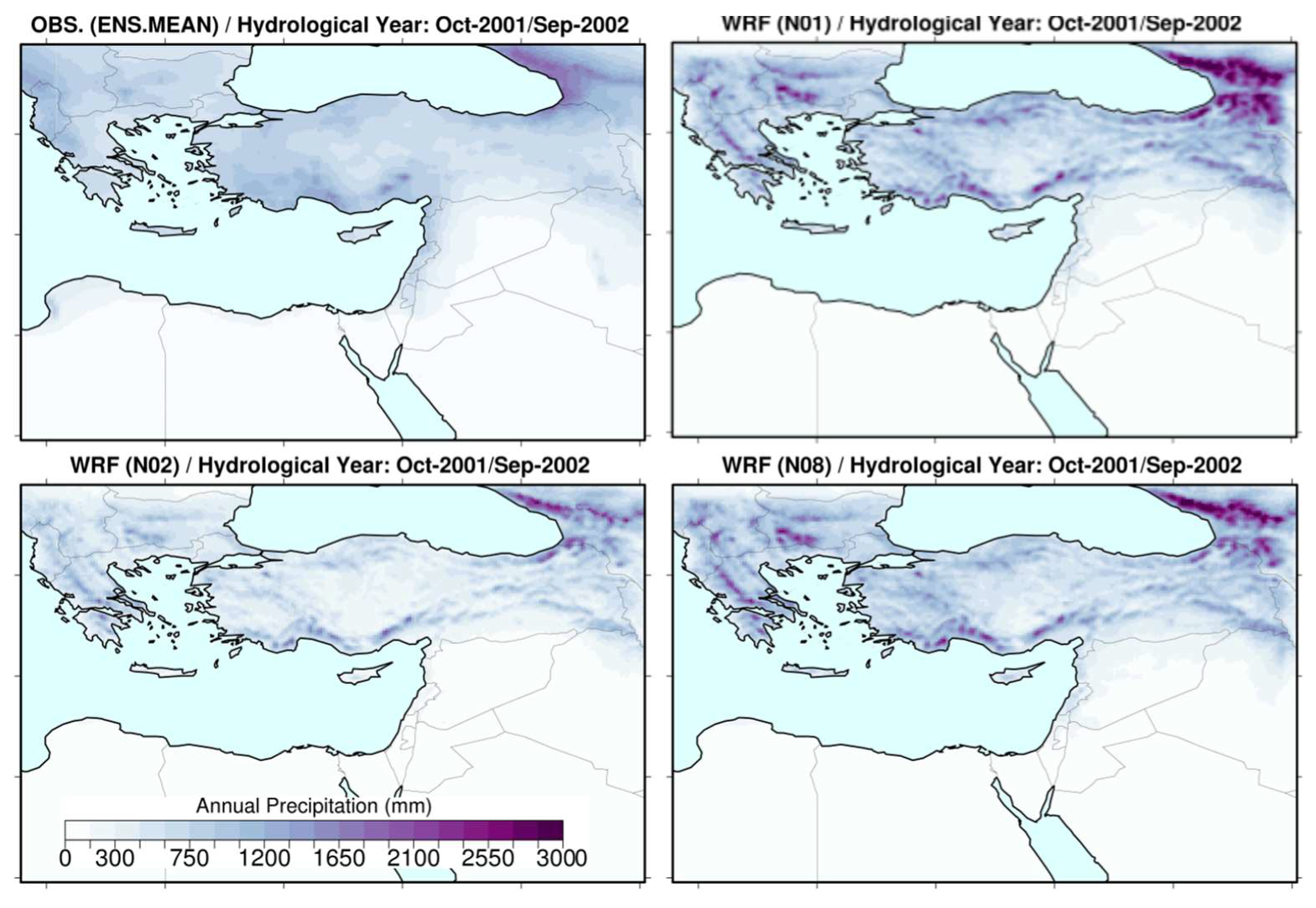
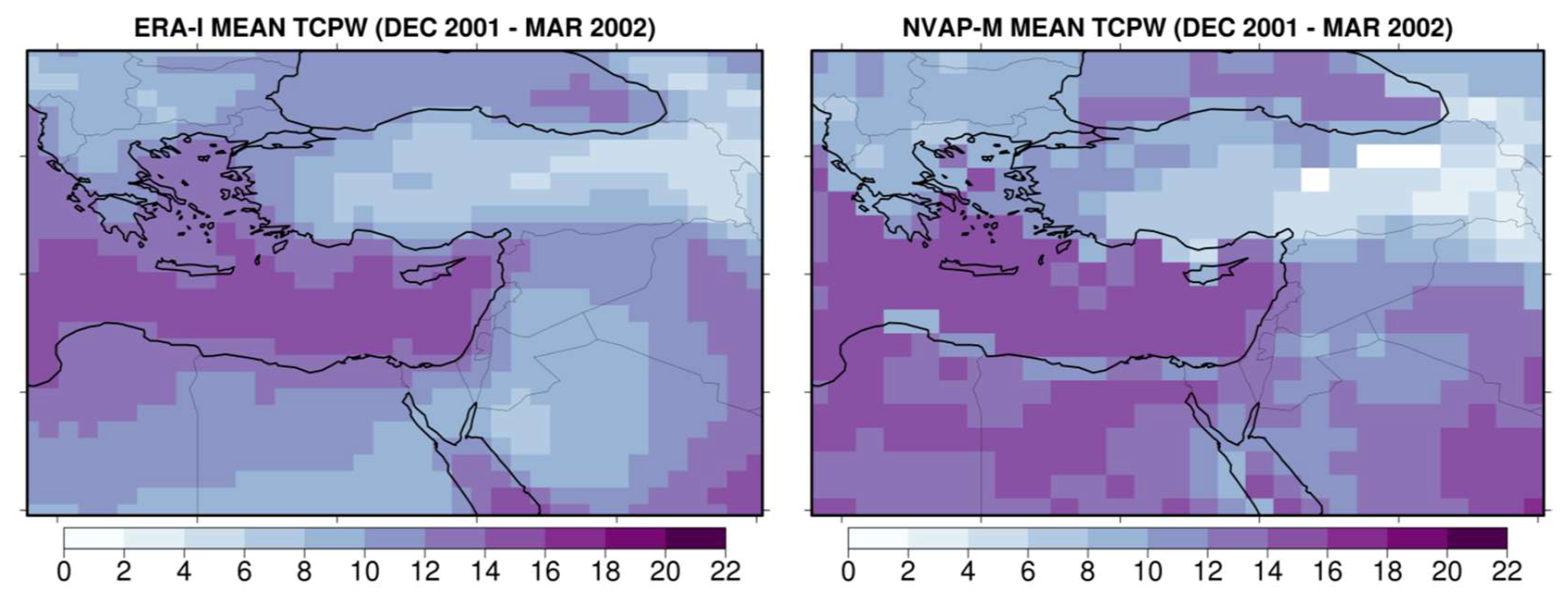
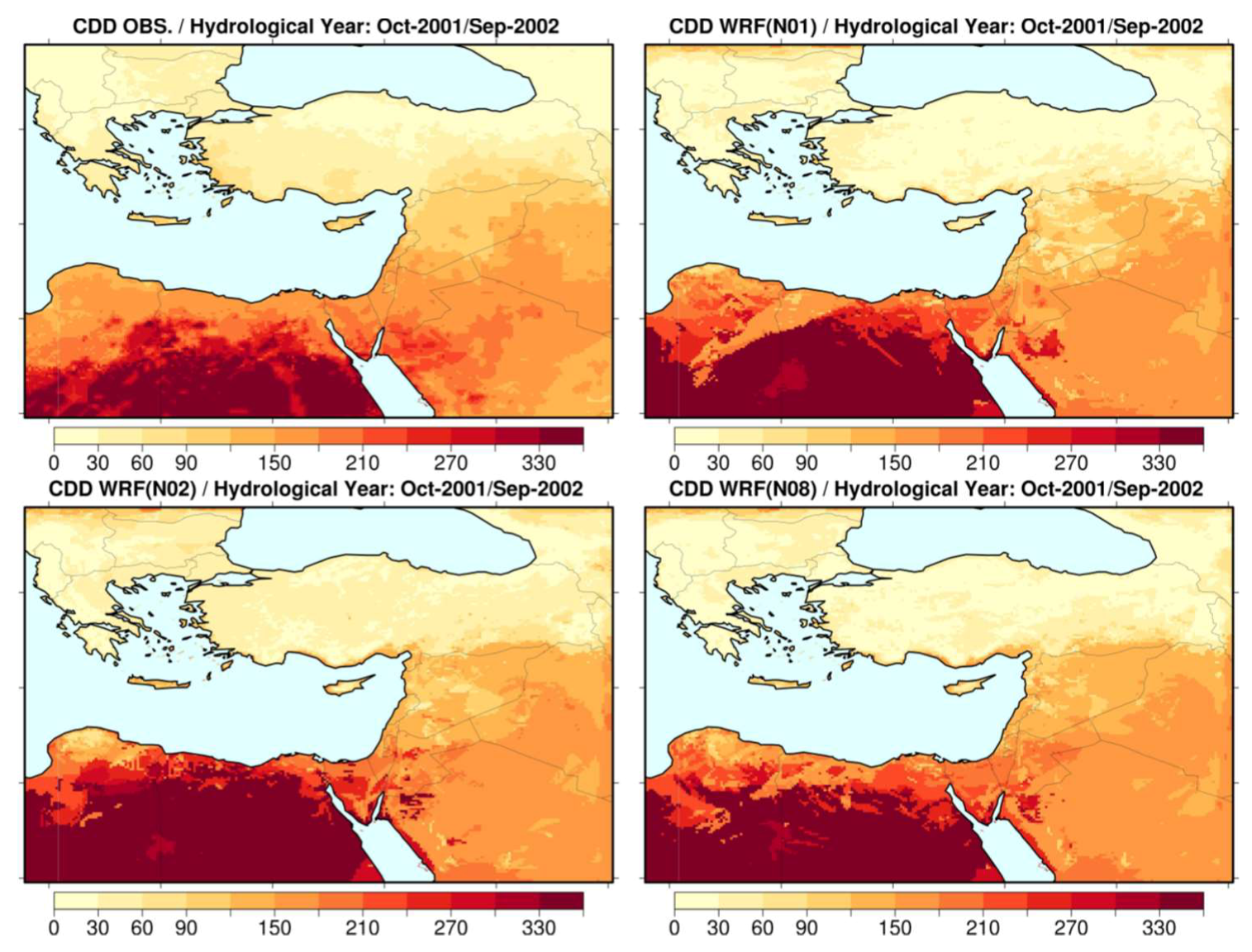
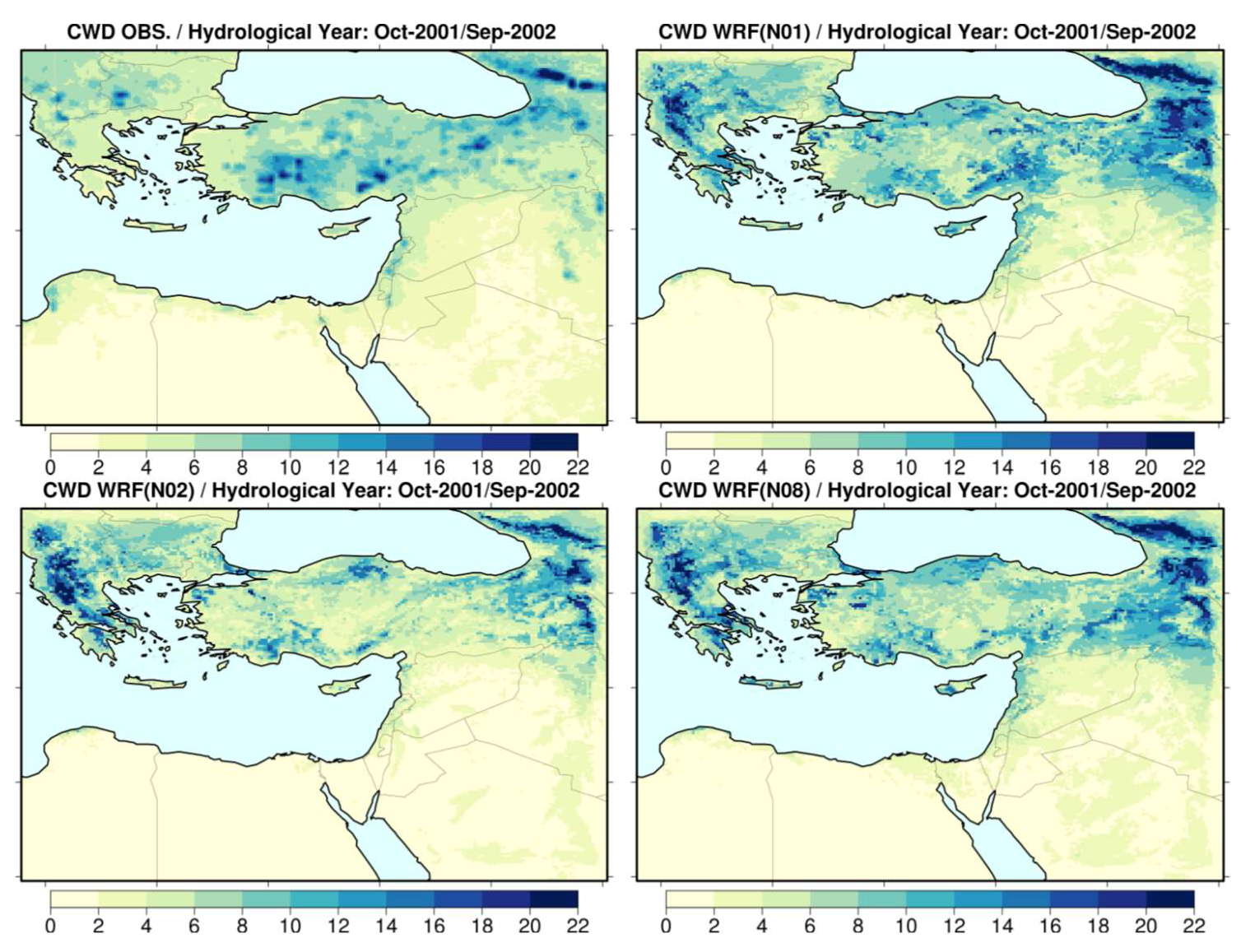
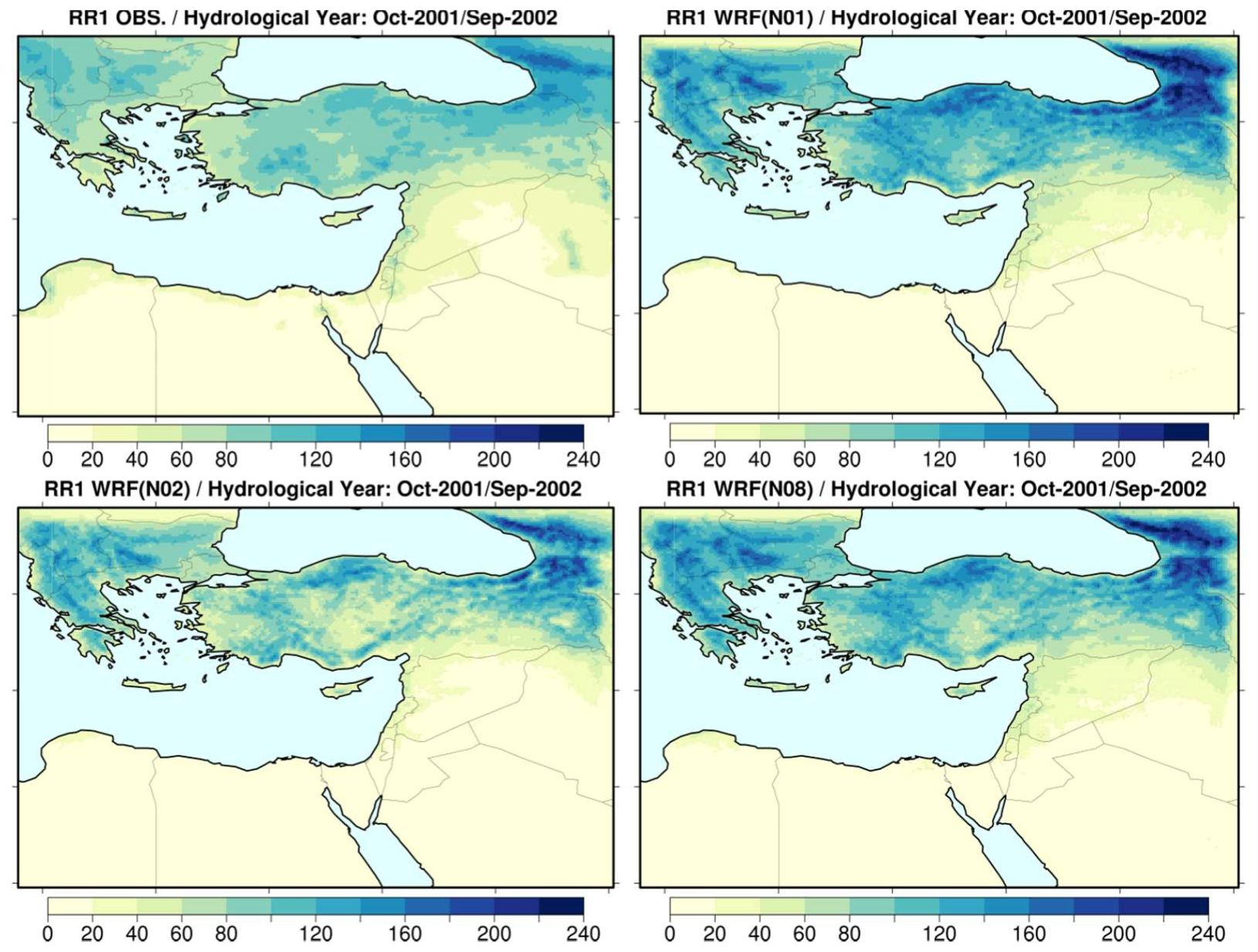
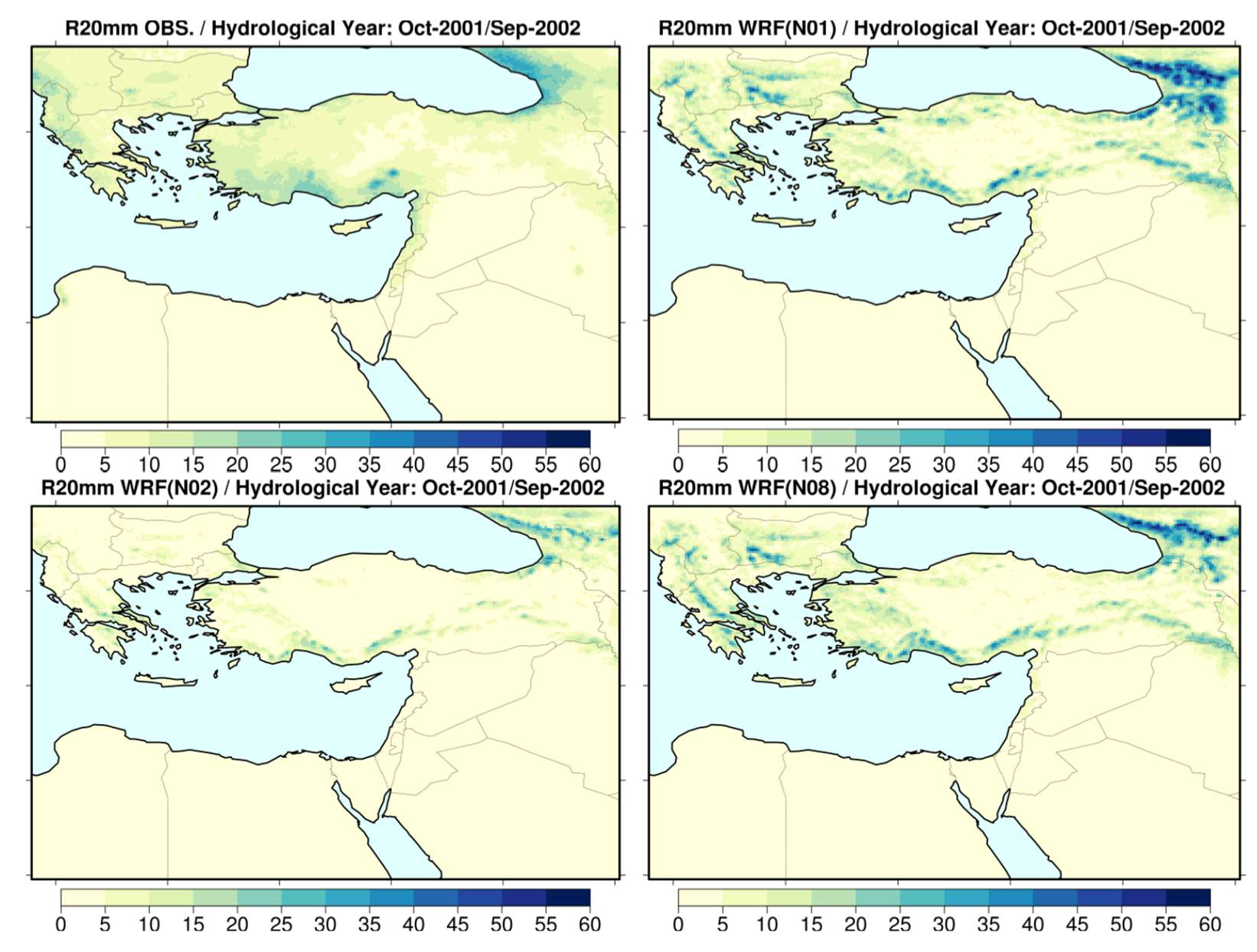
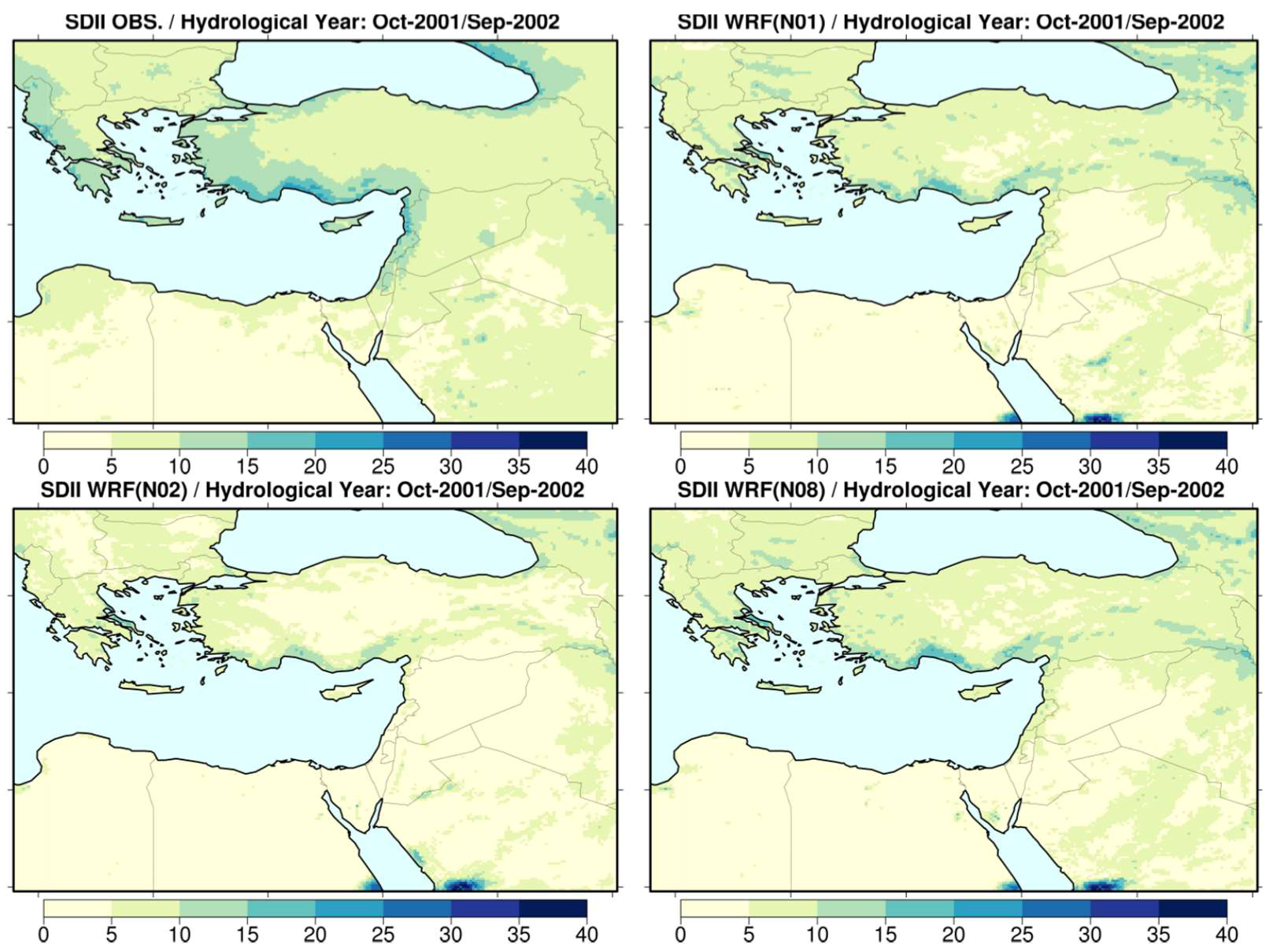
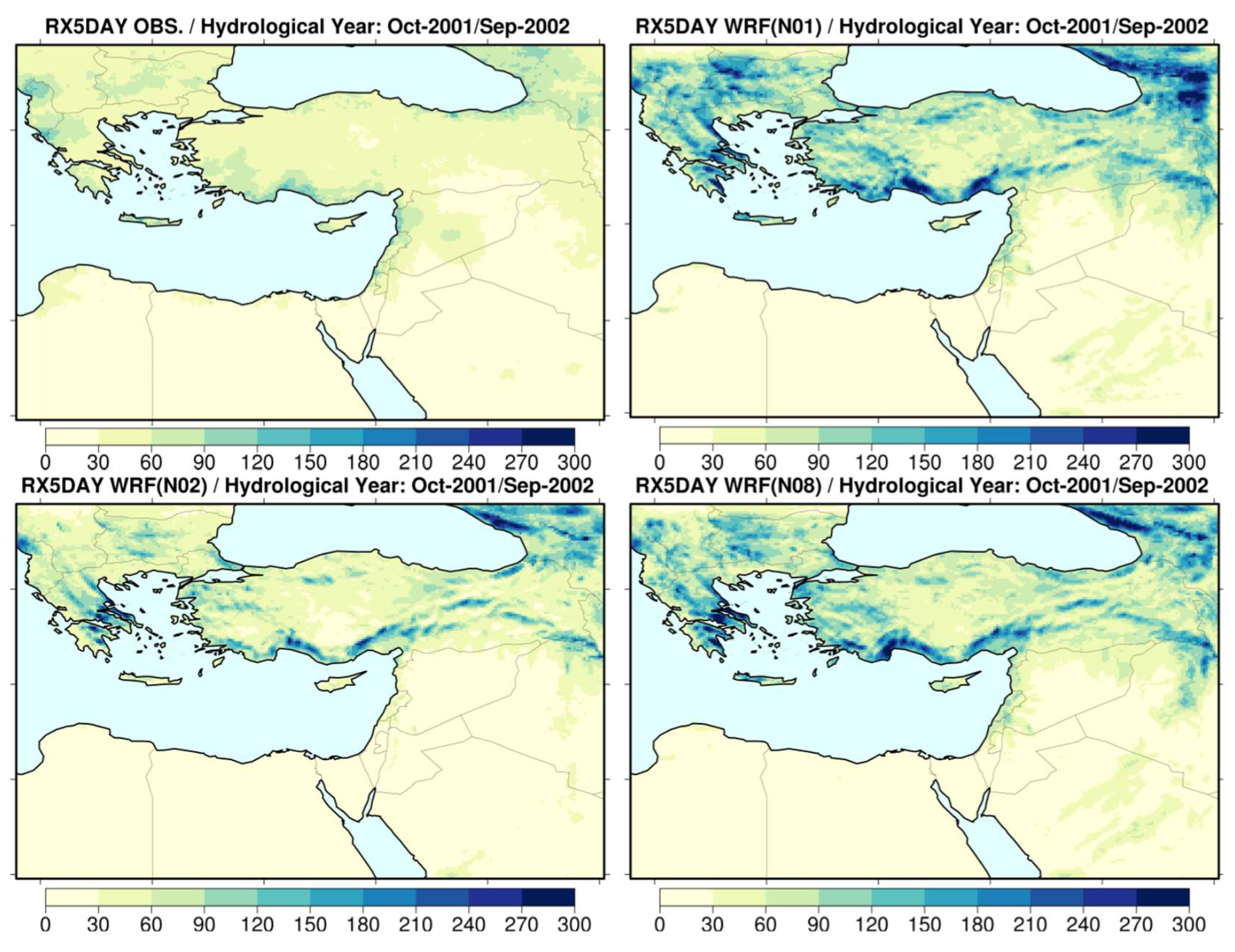
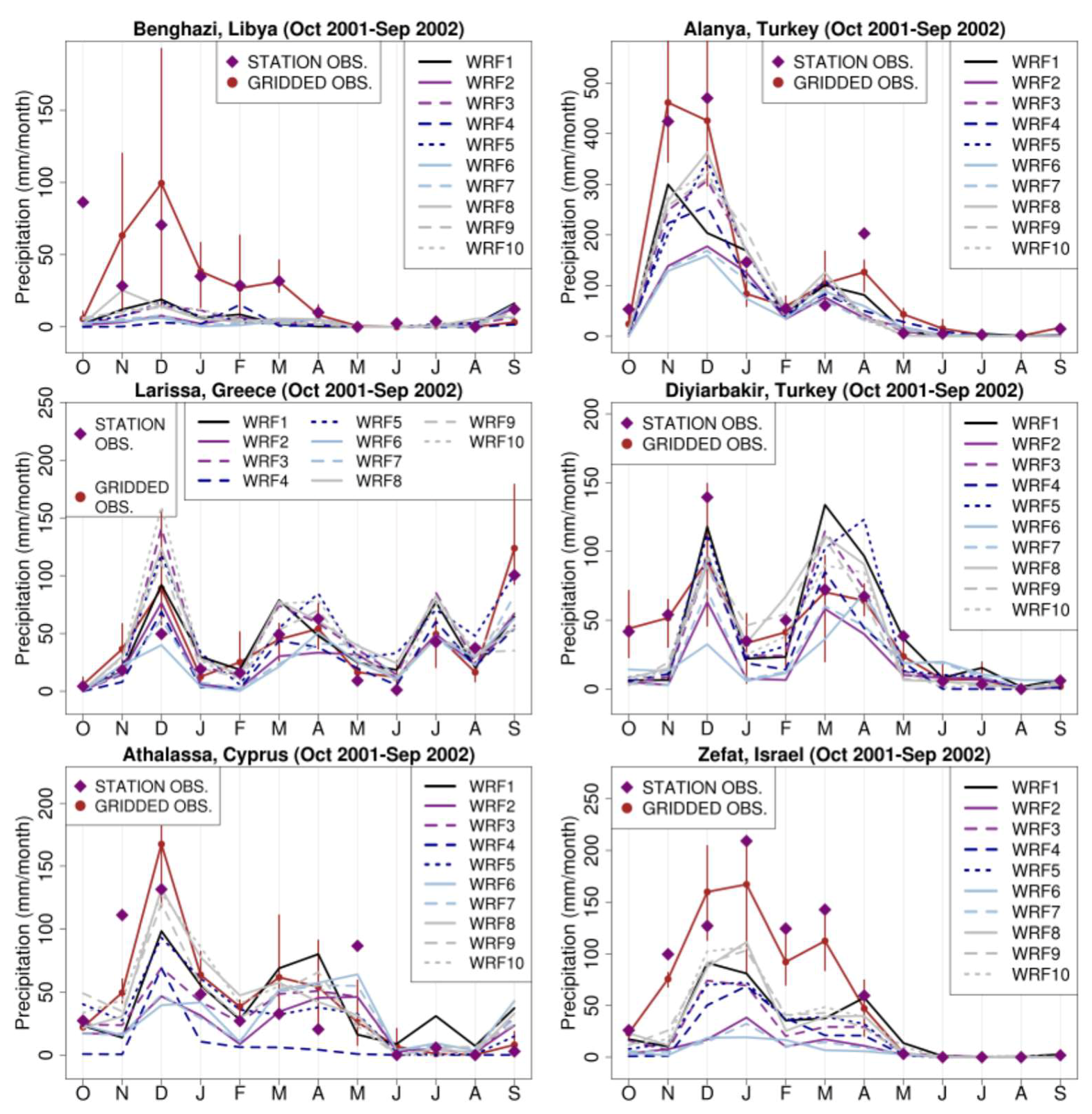
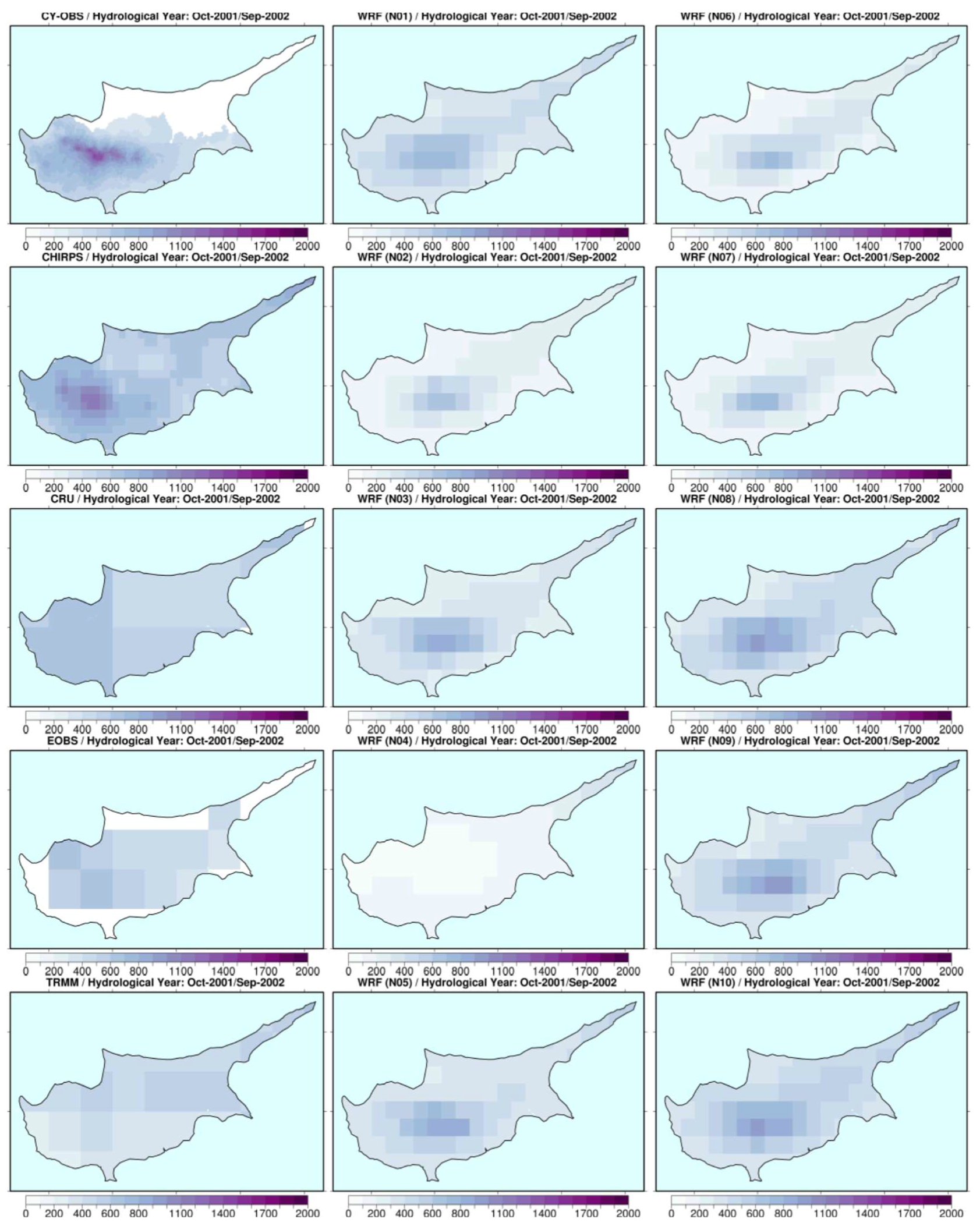
| ID: | Nudging Type | Nudging Interval (min) | Nudging Coefficients (sec−1) | Spectral Wavenumber | PBL Nudging | ||||
|---|---|---|---|---|---|---|---|---|---|
| Potential Temp. | U, V Wind Components | Water Vapor Mix. Ratio | Geopot. Height | X | Y | ||||
| WRF-01 | No nudge | 360 | — | — | — | — | — | — | NO |
| WRF-02 | Analysis | 360 | 3 × 10−4 | 3 × 10−4 | 3 × 10−4 | — | — | — | NO |
| WRF-03 | Analysis | 360 | 5 × 10−5 | 5 × 10−5 | 5 × 10−6 | — | — | — | NO |
| WRF-04 | Analysis | 360 | 3 × 10−4 | 3 × 10−4 | 3 × 10−4 | — | — | — | YES |
| WRF-05 | Analysis | 360 | 3 × 10−4 | 3 × 10−4 | — | — | — | — | NO |
| WRF-06 | Analysis | 1440 | 3 × 10−4 | 3 × 10−4 | 3 × 10−4 | — | — | — | NO |
| WRF-07 | Analysis | 720 | 3 × 10−4 | 3 × 10−4 | 3 × 10−4 | — | — | — | NO |
| WRF-08 | Spectral | 360 | 3 × 10−4 | 3 × 10−4 | — | 3 × 10−4 | 3 | 2 | NO |
| WRF-09 | Spectral | 360 | 3 × 10−4 | 3 × 10−4 | — | 3 × 10−4 | 3 | 2 | YES |
| WRF-10 | Spectral | 360 | 3 × 10−4 | 3 × 10−4 | — | 3 × 10−4 | 5 | 4 | NO |
| Dataset | Version | Grid Spacing | Temporal Resolution | Institution | Reference |
|---|---|---|---|---|---|
| CRU | 3.24.01 | 0.5° | Monthly (1901–Now) | Climate Research Unit, University of East Anglia | Harris et al., 2014 [31] |
| CHIRPS | 2.0 | 0.05° | Daily (1981–Now) | Climate Hazards Group | Funk et al., 2015 [32] |
| E-OBS | 15.0 | 0.25° | Daily (1950–Now) | ENSEMBLES (EU FP6 project) | Haylock et al., 2008 [33] |
| TRMM | 3B42RT | 0.5° | Daily (1979–Now) | National Aeronautics and Space Administration (NASA) | Huffman et al., 2007 [34] |
| CY-OBS | 1 km | Daily (1980–2010) | The Cyprus Institute | Camera et al., 2014 [35] |
| Station | Country | Longitude | Latitude | Elevation | Model Elevation | Model Land Use |
|---|---|---|---|---|---|---|
| Benghazi | Libya | 20.269° E | 32.097° N | 132 m | 82 m | Barren/Sparsely vegetated |
| Larissa | Greece | 22.466° E | 39.950° N | 73.5 m | 113 m | Croplands |
| Athalassa | Cyprus | 33.400° E | 35.150° N | 161 m | 206 m | Open shrubland |
| Zefat | Israel | 35.500° E | 32.967° N | 934 m | 363 m | Open shrubland |
| Diyiarbakir | Turkey | 40.201° E | 37.894° N | 686 m | 473 m | Croplands |
| Alanya | Turkey | 32.000° E | 36.550° N | 6 m | 313 m | Urban/Built-up |
| OBS | ERA-I | WRF01 | WRF02 | WRF03 | WRF04 | WRF05 | WRF06 | WRF07 | WRF08 | WRF09 | WRF10 | |
|---|---|---|---|---|---|---|---|---|---|---|---|---|
| Class 1 (43.9%) | 36 | −9 | −11 | −23 | −14 | −28 | −13 | −19 | −21 | −11 | −18 | 12 |
| Class 2 (16.5%) | 298 | −6 | −147 | −233 | −177 | −233 | −166 | −223 | −229 | −155 | −161 | −159 |
| Class 3 (33.6%) | 710 | −64 | 162 | −230 | 50 | −334 | 61 | −161 | −193 | 64 | −16 | 40 |
| Class 4 (5.9%) | 1242 | −293 | 386 | 249 | 161 | −445 | 209 | −104 | −194 | 155 | 9 | 134 |
| OBS | WRF01 | WRF02 | WRF03 | WRF04 | WRF05 | WRF06 | WRF07 | WRF08 | WRF09 | WRF10 | ||
|---|---|---|---|---|---|---|---|---|---|---|---|---|
| CDD | Class 1 | 225.5 | 13.4 | 33.3 | 24.4 | 51.4 | 20.4 | 23.8 | 30.8 | 18.6 | 27.5 | 21.0 |
| Class 2 | 129.9 | 4.8 | 22.3 | 14.1 | 46.7 | 13.4 | 11.7 | 19.2 | 20.0 | 22.1 | 21.8 | |
| Class 3 | 51.9 | −18.7 | −4.4 | −14.2 | 9.1 | −15.4 | −4.2 | −5.5 | −13.0 | −10.5 | −11.3 | |
| Class 4 | 33.4 | −11.6 | −3.0 | −9.0 | 5.1 | −9.6 | −4.6 | −4.5 | −7.8 | −7.9 | −6.8 | |
| CWD | Class 1 | 1.5 | −0.1 | −0.4 | −0.2 | −0.7 | −0.2 | −0.2 | −0.4 | −0.1 | −0.3 | −0.2 |
| Class 2 | 4.6 | −0.7 | −1.9 | −1.1 | −2.3 | −0.9 | −1.4 | −1.8 | −0.7 | −0.9 | −0.7 | |
| Class 3 | 6.7 | 2.5 | 0.5 | 1.7 | −1.7 | 1.7 | 2.1 | 1.1 | 2.0 | 1.3 | 1.7 | |
| Class 4 | 9.7 | 3.6 | 1.2 | 2.6 | −3.0 | 3.2 | 3.2 | 1.8 | 2.6 | 1.2 | 2.1 | |
| RR1 | Class 1 | 7.2 | −1.9 | −3.8 | −2.6 | −5.4 | −2.2 | −3.0 | −3.5 | −2.1 | −3.3 | −2.3 |
| Class 2 | 38.1 | −9.9 | −22.5 | −14.3 | −25.3 | −12.2 | −19.9 | −21.9 | −11.5 | −12.9 | −11.9 | |
| Class 3 | 79.3 | 31.6 | 4.8 | 24.2 | −22.5 | 25.8 | 15.6 | 10.5 | 24.4 | 16.3 | 21.0 | |
| Class 4 | 113.9 | 35.8 | 8.7 | 25.3 | −24.8 | 28.0 | 19.3 | 13.3 | 23.4 | 17.7 | 20.6 | |
| R20 | Class 1 | 0.1 | 0.0 | −0.1 | 0.0 | −0.1 | 0.0 | −0.1 | −0.1 | 0.0 | 0.0 | 0.0 |
| Class 2 | 2.7 | −1.9 | −2.5 | −2.1 | −2.4 | −2.1 | −2.5 | −2.5 | −2.0 | −2.0 | −2.0 | |
| Class 3 | 7.9 | 0.7 | −4.8 | −1.0 | −5.0 | −1.1 | −4.4 | −4.6 | −0.8 | −1.7 | −0.9 | |
| Class 4 | 17.7 | 4.5 | −7.6 | 0.3 | −8.2 | 0.7 | −5.5 | −6.8 | 0.4 | −2.0 | 0.1 | |
| SDII | Class 1 | 3.9 | −1.1 | −1.9 | −1.3 | −1.8 | −1.4 | −1.8 | −1.9 | −1.2 | −1.3 | −1.1 |
| Class 2 | 7.4 | −3.0 | −4.2 | −3.3 | −3.5 | −3.3 | −4.1 | −4.1 | −2.9 | −3.0 | −3.0 | |
| Class 3 | 9.6 | −1.9 | −4.1 | −2.5 | −3.2 | −2.5 | −4.0 | −4.1 | −2.3 | −2.5 | −2.3 | |
| Class 4 | 12.7 | −2.1 | −4.8 | −2.8 | −3.9 | −2.7 | −4.4 | −4.7 | −2.6 | −3.3 | −2.6 | |
| RX5D | Class 1 | 9 | 1.3 | −3.3 | 0.6 | −4.3 | 0.4 | −1.8 | −2.8 | 1.2 | −0.6 | 1.1 |
| Class 2 | 35.8 | −4.8 | −19.5 | −8.3 | −16.5 | −8.9 | −17.6 | −18.6 | −4.7 | −6.5 | −5.9 | |
| Class 3 | 51.3 | 44.9 | 10.5 | 35.6 | 8.7 | 33.3 | 14.1 | 12.0 | 34.8 | 28.8 | 34.6 | |
| Class 4 | 74.1 | 87.4 | 30.8 | 64.1 | 25.5 | 60.7 | 43.0 | 33.2 | 60.1 | 47.2 | 60.5 |
| WRF01 | WRF02 | WRF03 | WRF04 | WRF05 | WRF06 | WRF07 | WRF08 | WRF09 | WRF10 | ||
|---|---|---|---|---|---|---|---|---|---|---|---|
| COR | Class 1 | 0.50 | 0.49 | 0.52 | 0.56 | 0.48 | 0.4 | 0.47 | 0.52 | 0.52 | 0.53 |
| Class 2 | 0.81 | 0.76 | 0.83 | 0.76 | 0.82 | 0.72 | 0.75 | 0.84 | 0.84 | 0.84 | |
| Class 3 | 0.71 | 0.71 | 0.74 | 0.76 | 0.73 | 0.65 | 0.68 | 0.76 | 0.78 | 0.77 | |
| Class 4 | 0.56 | 0.56 | 0.55 | 0.55 | 0.55 | 0.5 | 0.56 | 0.56 | 0.56 | 0.56 | |
| MAE | Class 1 | 2.1 | 2.1 | 2.1 | 2.1 | 2.1 | 2.3 | 2.1 | 2.1 | 2.0 | 2.2 |
| Class 2 | 10.1 | 12.6 | 10.1 | 12.4 | 9.9 | 12.6 | 12.5 | 9.6 | 9.5 | 9.7 | |
| Class 3 | 35.6 | 28.7 | 31.0 | 31.0 | 30.8 | 28.8 | 28.6 | 30.2 | 26.3 | 29.5 | |
| Class 4 | 70.9 | 48.9 | 61.3 | 52.5 | 62.7 | 54.1 | 49.4 | 59.2 | 52.6 | 60.0 | |
| MIA | Class 1 | 0.43 | 0.31 | 0.39 | 0.22 | 0.42 | 0.32 | 0.31 | 0.42 | 0.37 | 0.41 |
| Class 2 | 0.58 | 0.35 | 0.54 | 0.34 | 0.56 | 0.37 | 0.36 | 0.6 | 0.58 | 0.59 | |
| Class 3 | 0.59 | 0.52 | 0.6 | 0.48 | 0.61 | 0.52 | 0.52 | 0.62 | 0.64 | 0.62 | |
| Class 4 | 0.54 | 0.49 | 0.53 | 0.44 | 0.52 | 0.48 | 0.49 | 0.53 | 0.53 | 0.52 | |
| TS | Class 1 | 0.79 | 0.64 | 0.75 | 0.52 | 0.8 | 0.68 | 0.63 | 0.78 | 0.77 | 0.77 |
| Class 2 | 0.37 | 0.08 | 0.29 | 0.08 | 0.31 | 0.11 | 0.1 | 0.35 | 0.29 | 0.31 | |
| Class 3 | 0.55 | 0.36 | 0.57 | 0.18 | 0.57 | 0.45 | 0.41 | 0.59 | 0.61 | 0.58 | |
| Class 4 | 0.28 | 0.38 | 0.33 | 0.23 | 0.33 | 0.43 | 0.4 | 0.33 | 0.38 | 0.33 |
© 2018 by the authors. Licensee MDPI, Basel, Switzerland. This article is an open access article distributed under the terms and conditions of the Creative Commons Attribution (CC BY) license (http://creativecommons.org/licenses/by/4.0/).
Share and Cite
Zittis, G.; Bruggeman, A.; Hadjinicolaou, P.; Camera, C.; Lelieveld, J. Effects of Meteorology Nudging in Regional Hydroclimatic Simulations of the Eastern Mediterranean. Atmosphere 2018, 9, 470. https://doi.org/10.3390/atmos9120470
Zittis G, Bruggeman A, Hadjinicolaou P, Camera C, Lelieveld J. Effects of Meteorology Nudging in Regional Hydroclimatic Simulations of the Eastern Mediterranean. Atmosphere. 2018; 9(12):470. https://doi.org/10.3390/atmos9120470
Chicago/Turabian StyleZittis, George, Adriana Bruggeman, Panos Hadjinicolaou, Corrado Camera, and Jos Lelieveld. 2018. "Effects of Meteorology Nudging in Regional Hydroclimatic Simulations of the Eastern Mediterranean" Atmosphere 9, no. 12: 470. https://doi.org/10.3390/atmos9120470
APA StyleZittis, G., Bruggeman, A., Hadjinicolaou, P., Camera, C., & Lelieveld, J. (2018). Effects of Meteorology Nudging in Regional Hydroclimatic Simulations of the Eastern Mediterranean. Atmosphere, 9(12), 470. https://doi.org/10.3390/atmos9120470









